The following essay will appear in Climates: Architecture and the Planetary Imaginary, published this spring by the Avery Review and Lars Müller Publishers.
“The first night of living in a Masdar apartment was hilarious. I didn’t understand how anything worked: the stove, the lights, the bathroom faucet, the cabinets, and I couldn’t figure out how to turn off the AC,” wrote Laura Stupin on her blog in September 2010, just after moving into the new Masdar Institute campus. Her studio apartment was situated at the center of Masdar City, inside a dormitory building she shared with her fellow students. “The Masdar Institute is the first part of the city to be completed, it includes the library, laboratory buildings, and the student residences,” Laura continued, “and all these buildings fit together in a cube. And this cube is located in the middle of what is still a giant, flat, dusty, deserty construction site as progress on other phases of the city continues. It’s quite a mind flip to be in such a strangely beautiful environment, then look [out] a window and see flat dusty landscape stretching out to the horizon. It really feels like I’m living in a spaceship in the middle of the desert.”1
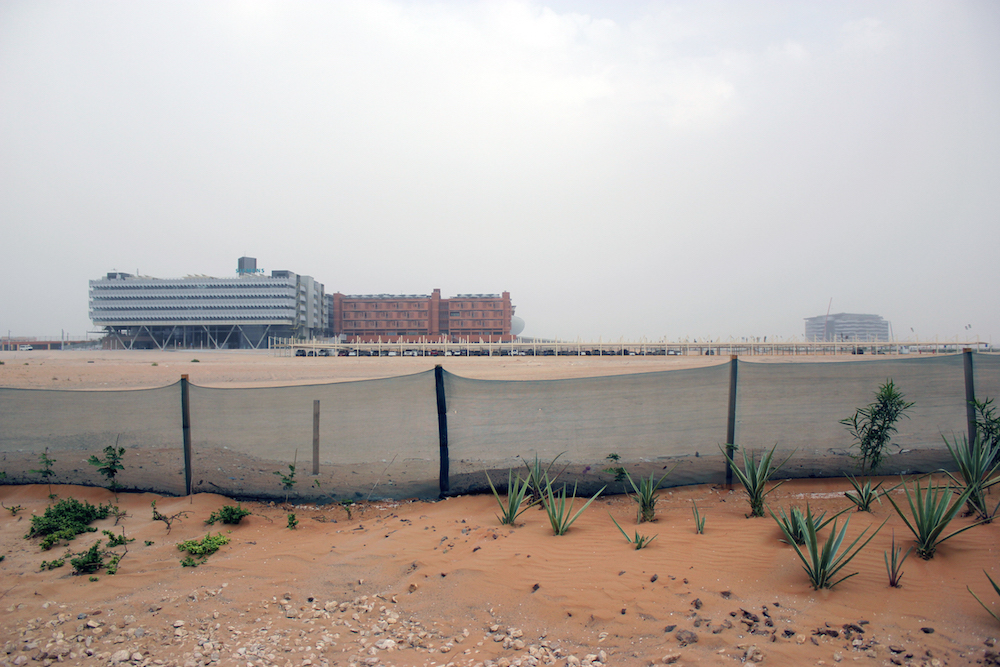
Laura was in her mid-twenties, and had moved to Abu Dhabi from the United States, after receiving her bachelor’s degree from a private undergraduate engineering college in Massachusetts. Her ambition was to learn about renewable energy and clean technology at Masdar. In September 2010, when she posted her entry titled “I Live in a Spaceship in the Middle of the Desert,” she received unexpected attention from journalists and researchers around the world. Major media outlets, such as the Guardian newspaper, reviewed her comments.2 Like the other students who had moved to Masdar, she was trying to make sense of her experience with Abu Dhabi’s emergent renewable energy and clean technology infrastructures.
Masdar, meaning “source” in Arabic, was founded in May 2006 as a multifaceted renewable energy and clean technology company. It is widely known for Masdar City, the “futuristic” eco-city master-planned to rely entirely on renewable energies by the London-based architects Foster + Partners. While the eco-city and its multiple infrastructures were central to Masdar’s development, Masdar has also been investing in renewable energy through its other operations—Masdar Power, Masdar Carbon, and Masdar Capital—in an attempt to ensure Abu Dhabi will remain a significant player in the global energy industry well after its oil reserves run dry. Masdar Institute, the energy-focused research center, set up and supervised by MIT’s Technology and Development Program, operates on a growing campus within the eco-city site. This campus was Laura’s “spaceship in the desert.”
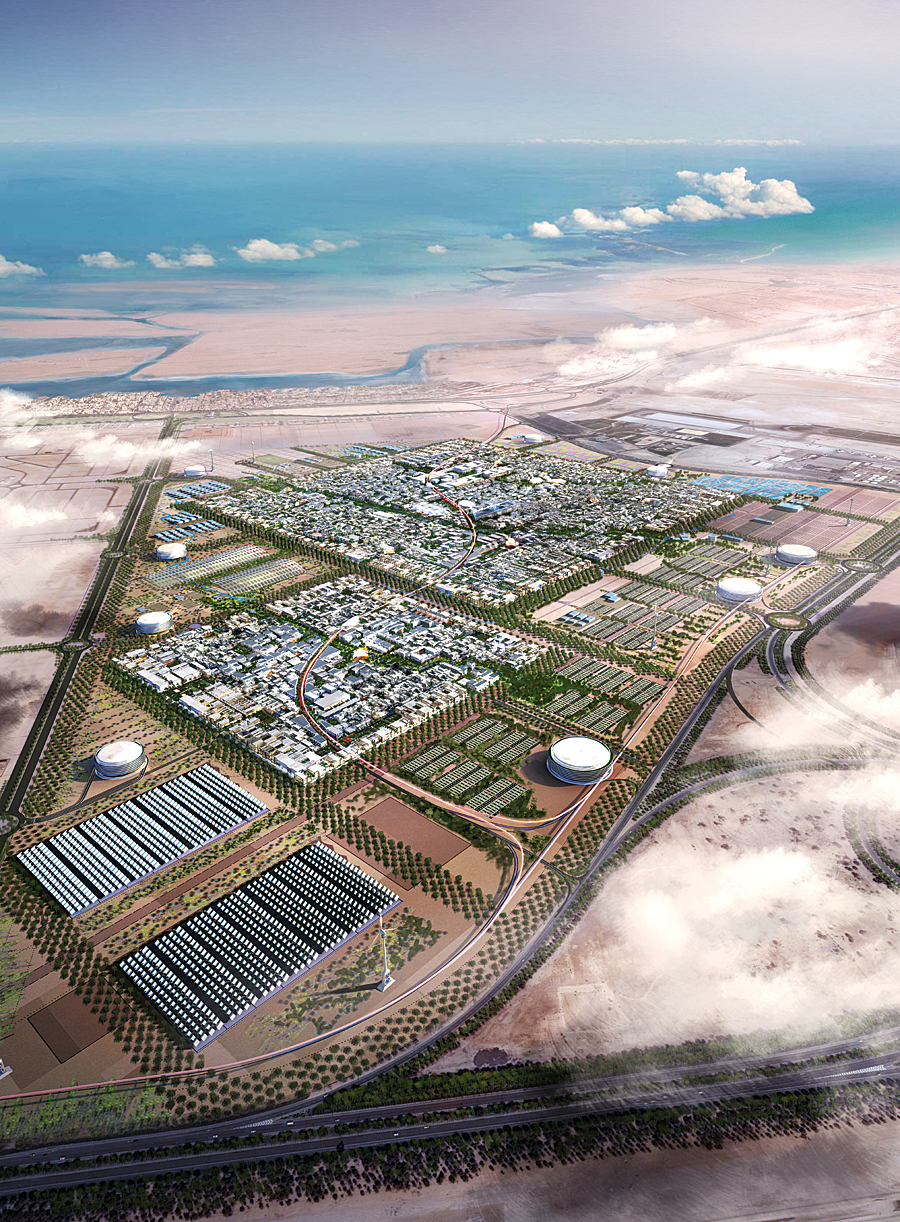
Since the 1960s, space technologies have inspired ecologically sensitive architecture, producing a blueprint for survival in a context of rising environmental concerns. As historians of science such as Peder Anker and Sabine Höhler note in their overviews of ecological design, the space program of the 1960s had considerable impact on the ways in which designers imagined and planned eco-friendly life on earth.3 Buildings, perhaps best symbolized by the well-known Biosphere 2 project, would constitute self-regulating and decentralized systems with comfortable climatic conditions for humans, provide enclosed shelters for an impending ecological disaster, and perhaps serve as a means of escape from possible destruction on earth. Occupying buildings inspired by space technologies, humanity would behave like astronauts with clear outer space missions.
In these histories, the spaceship is a finite, technically sophisticated, and insular habitat for an exclusive group of beings facing an outside world of crises. In his book Shipwreck with Spectator, Hans Blumenthal explains how humans “prefer in their imagination, to represent their overall condition in the world in terms of a sea voyage.”4 The idea of the spaceship (much like the submarine that preceded it) then serves as an extension of the ship metaphor, demonstrating the inevitable boundaries of human activities, vilifying the space beyond human habitability, and producing the outside as a vacuum that should not be inhabited. As seas full of mythical monsters surround the livable environments on earth, the ship provides a safe interior space. Thanks to its strict boundaries, it acts as an ark, or as the German philosopher Peter Sloterdijk suggests, an “autonomous, absolute, context-free house, the building with no neighborhood.”5 This way, the ship puts forward an alternative environment of peace and rationality, standing in opposition to the destructive and irrational crises of earth.
In prioritizing enclosure for some over collective survival—the tension that underpins most space-faring movies—the spaceship also advances the principles of selection and endorses what Sloterdijk calls “exclusivity dressed up as universalism.” Despite saving only a very small number of those who suffer a metaphorical shipwreck, the spaceship insists on addressing the planetary-scale questions of survival in the unknown, the sustenance of the species beyond ecological disasters, and the preservation of an existing civilization albeit in highly limited and confined form.

The Moon Landing
Inspired by this history of ecological architecture, Masdar City is intended to maintain the lives (and livelihoods) of its residents by relying on renewable energy and clean technologies, and performs the role of “a spaceship in the desert.” This ecological mandate would assist Norman Foster, founder and chairman of Foster + Partners, in producing a legacy for himself. According to one of the on-site Foster + Partners architects, “Norman wants to be the Bucky Fuller of this century.”
Buckminster Fuller conceived of the earth as a beautifully designed spaceship that lacks comprehensible instructions. To satisfy this need, he wrote Operating Manual for Spaceship Earth.6 “We are all astronauts,” Fuller asserted. “We have not been seeing our Spaceship Earth as an integrally-designed machine which to be persistently successful must be comprehended and serviced in total.”7 Since “no instruction book came with it,” humankind was confronted with the challenge of self-instruction in order to successfully operate Spaceship Earth and “its complex life-supporting and regenerating systems.” Earth was an operable technological object, fully accessible to humankind. Fuller not only wrote about his technocratic understandings of earth but also conceived many design and engineering projects illustrating his philosophy, such as the geodesic dome.
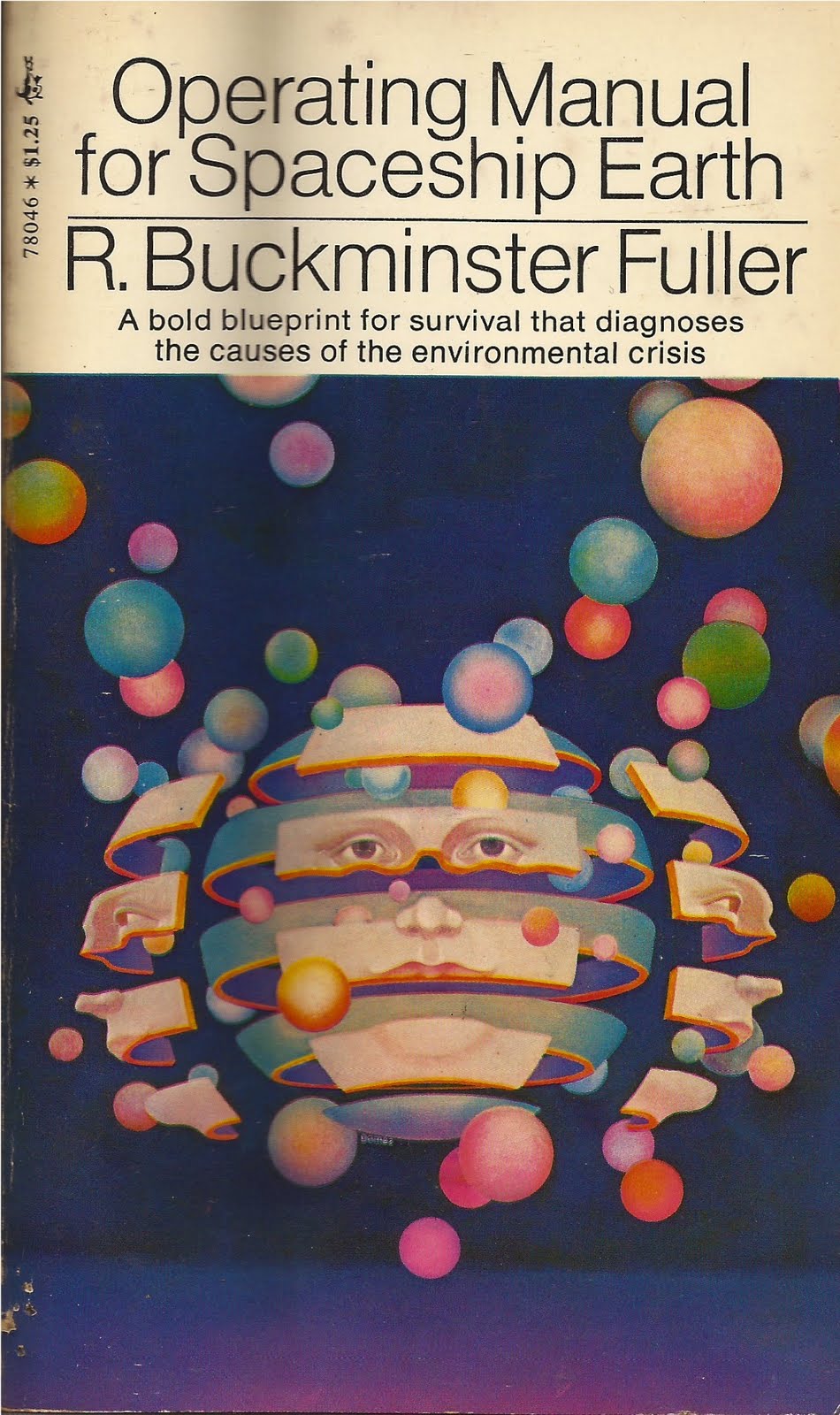
As a young architect, Norman Foster met Buckminster Fuller in 1971 to collaborate on the construction of the Samuel Beckett Theater in Oxford. The theater, which marked the beginning of their twelve-year relationship, was a subterranean building intended to be used as classrooms and exhibitions space for St. Peter’s College. It benefited from the geodesic, lightweight structures that made Fuller famous. Although it was never built, Foster claims this building had a significant impact on the later stages of his career, not only because it initiated his relationship with Fuller but also in more formal ways: “I remember that Bucky made the comparison with a submarine because the structure of the building had to be resistant to water, like a seaworthy vessel. The building had to stand up to the ground water and other natural underground forces. So it’s no coincidence that my later underground projects also take the form of ships and submarines.”8 Although none of their collaborative projects were built, in his Pritzker Prize biography, Foster says, “The thing about Bucky was that he made you believe anything is possible.” Foster adds, “But perhaps the themes of shelter, energy and environment—which go to the heart of contemporary architecture—best reflect Bucky’s inheritance… For me Bucky was the very essence of a moral conscience, forever warning about the fragility of the planet and man’s responsibility to protect it.”9 For Foster, Fuller was what he termed “a green guru.”
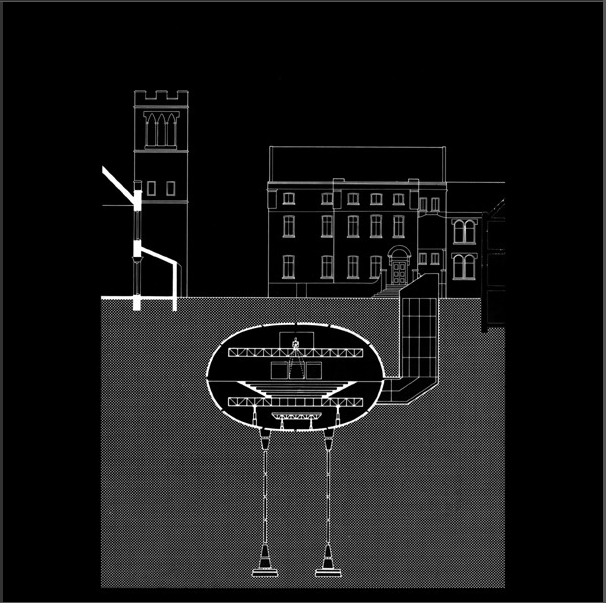
The legacy of the ship and the submarine continues to inform Norman Foster’s design work. For instance, an article in the Guardian suggested that Foster’s “reassuringly technical, graceful, silver, white, and immaculate” designs would be suitable for architecture on the moon.10 More recently, Foster + Partners publicized renderings for a settlement on Mars, constructed by robots prior to the arrival of humans. “Designing for extra-terrestrial environments provides an exciting platform for experimentation that is at the front line of innovative technology,” one of Foster’s partners commented.11
In conversation with this lineage of outer space designs, Norman Foster also proposed that he understood practicing architecture in the Arabian Gulf to be similar to lunar exploration.12 News commentaries, rather fascinated with the idea of constructing an eco-friendly city in the desert accordingly state, “The inhospitable terrain suggests that the only way to survive here is with the maximum of technological support, a bit like living on the moon.”13 In his autobiography, the leading Emirati entrepreneur and businessman Easa Al-Gurg also demonstrates that Emirati rulers understood the desert as a moonscape by describing how Sheikh Rashid bin Saeed Al Maktoum of Dubai dismissed the moon landing as a hoax, arguing that the landscape looked like the empty terrain in Ras Al-Khaimah, one of the seven emirates that make up the UAE. “Maybe it was filmed there,” Sheikh Rashid said.14
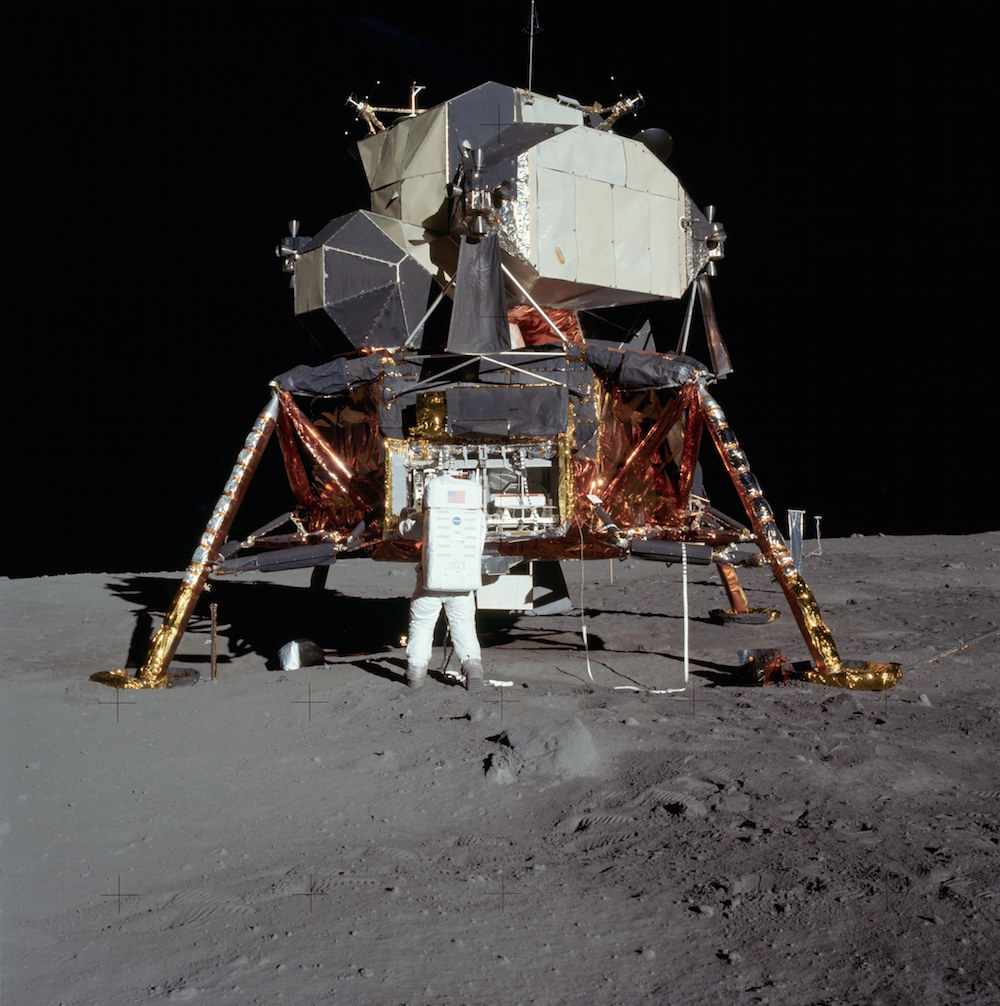
Quite appropriately, the on-site architecture team at Masdar presented a slide show that included an image, juxtaposing a Lunar Module with the gray, lightweight cladding of the laboratory buildings on the Masdar Institute campus. The laboratory façades were composed of insulating cushions, the architects explained, which shaded the interiors of the building and remained cool to the touch under the desert sun. In December 2010, Fred Moavenzadeh, then president of Masdar Institute, spoke on Richard Quest’s CNN documentary about Masdar City and explained that when the United States wanted to send a man to the moon, it produced NASA. Now, when the United Arab Emirates is transforming and diversifying its economy, it is building Masdar City.15
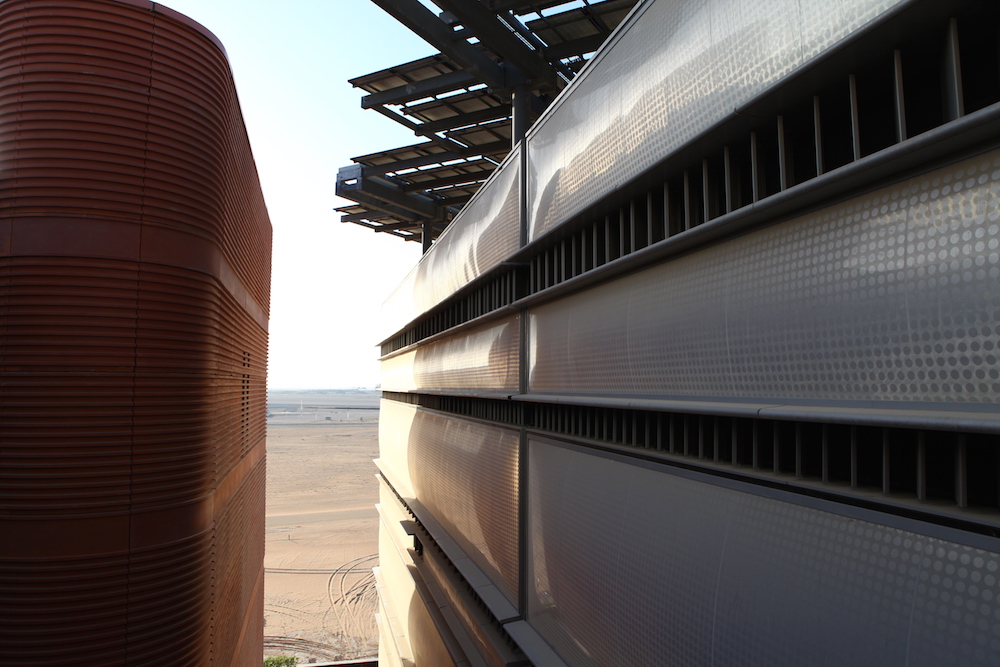
The Frontier
The spaceship analogy reconfigured the desert as an undiscovered frontier from which a novel means of livelihood could emerge.16 In this voyage, the frontierspeople of Masdar City would be in control, both abiding by the principles of the Abu Dhabi government, and taking initiative to trigger a future of innovations in renewable energy and clean technology. In an ever-expanding geography, the students would act as astronauts—steering the spaceship and managing the successful institution of a new resource economy within oil-exporting Abu Dhabi. Perhaps this could be the reason why Laura’s blog featured an optimistic comment from a former Masdar employee: “Brave people living on the island, it will get better and better…”
In his book Carbon Democracy, Timothy Mitchell shows how conceptions of endless oil supplies enabled progress to be conceived as infinitely expandable and without any material constraints. In the mid-twentieth century, the cost of energy did not present a limit to economic growth, as oil prices continuously declined. Given how simple it was to ship oil across the world, this resource could easily be treated as inexhaustible. This belief in the infinity of oil also played a key role in producing “the economy” as an object, which could likewise expand without limit.17
In contrast to this history of oil, the Masdar City project acknowledges the fact that fossil fuels may eventually disappear. Nevertheless, the idea of resource infinity, this time enabled by renewable energy and clean technology, still characterizes the ways in which producers of the city imagine the future. In response to depleting oil resources, the eco-city promotes the infinity of sunlight and wind. The spaceship in the desert has the capacity to journey through endless space and confirm the vision of a boundless frontier where new types of resources await discovery.18 As an exploratory vehicle, the Masdar City project is intended to challenge and resolve the problem of finitude. The frontier narrative also led the producers of Masdar City to conceptualize the present as a moment of potential while concentrating their efforts on constructing a future that would be incubated inside this enclosed space within the Abu Dhabi desert. Masdar City could give rise to a new generation of resource pioneers, who would hurdle through unbounded territory.19 Accordingly, it was not only the space of the Abu Dhabi desert that awaited another discovery but also its temporality. The spaceship analogy spoke to a future of technical adjustments that would potentially emerge from this enclosed space, possibly allowing the eco-city to be replicated in other settings around the world.
Exporting the Spaceship
Nevertheless, Masdar Institute students, the frontierspeople of Abu Dhabi’s emergent eco-city experiment, remained unsure about the translatability of Masdar City into other settings. As such, on February 1, 2011, they gathered in the Masdar Institute auditorium to stage a debate on whether “Masdar City is an elite enclave of sustainability, unsuitable for the rest of the world” or not. The graduate students, who came to Masdar City from countries like the United States, China, India, Egypt, Jordan, Iran, Turkey, and Iceland, were struggling with such questions, and chose the context of a debate club performance as a way of thinking about them.
The team that perceived Masdar City as “an elite enclave of sustainability” argued how Masdar is “too unique” to be applied elsewhere. First, Masdar was very expensive. Which other country, other than the oil-rich UAE, would be able to devote $22 billion for an eco-city?20 Second, they recalled how this project had been put together to contribute to the economic diversification of Abu Dhabi, and perhaps would not be financially feasible or meaningful for other countries with different economies. Masdar City was expected to help the UAE transform its brand image from oil producer to technology developer, and induce a perception shift, perhaps attracting foreign investments or facilitating the creation of local start-up companies focusing on renewable energy and clean technology. Third, the political climate of Abu Dhabi was working in favor of Masdar City by providing prolonged commitment and stability—the government often served as a steady source of financing for the project. “Well, other than that,” the pro-team reiterated, “the concept of a green city has existed for a long time.” In this understanding, Masdar City no longer comprised a vision that would unfold into the future. Rather, it remained an island contingent on a specific set of circumstances, only available within the United Arab Emirates. Abu Dhabi’s oil capital, its future economic vision, and its political environment were thus perceived as preconditions for launching the spaceship.
In response, the team that defended the global applicability of Masdar City proposed that the eco-city should rather be understood and framed as a prototype: Abu Dhabi would shoulder the burdens of building the eco-city, and others would benefit. “Every new idea is expensive,” one of the students underlined. “Think about the car: first rich people had it and now it has spread around the world.” Masdar City could become less expensive in an undefined future. It could be exported to other countries as a whole, in the same way that the car and its infrastructures had been exported. In the meantime, the experiments taking place at Masdar would be learning experiences for the students, researchers, and faculty, opening up global horizons for research on renewable energy and clean technology and eventually adapting them to other regions in bits and pieces.
At the end of the meeting, one student approached me to express his dissatisfaction at how none of the students in the debate teams had actually defined what Masdar City was or what exactly they expected to spread around the world: “No one talked about the personal rapid transit units or the motion sensors,” he specified, pointing to the technological artifacts that seemingly defined the eco-city for him. In which of its materializations did Masdar inhere, and what would it pass on to the rest of the world, he wondered, and what exactly was the future that the spaceship promised?
Man with a Brush
Abu Dhabi is perceived to be a perfect location for harnessing solar energy. However, according to an engineer at Masdar—let’s call him Mahmood—this perception was not completely accurate. Mahmood was an Egyptian man in his mid-thirties, and had recently finished his Ph.D. at an American university. Wishing to be closer to home, he accepted a position at Masdar as his first job. As we chatted outside the solar power stations, he stated that high levels of dust and humidity not only blocked direct solar rays but also resulted in thick coatings on solar panels, diminishing their effective functioning. “Although we can’t fix the first problem that easily, we have found a solution for the second problem.” He continued, “We call it ‘man with a brush.’”
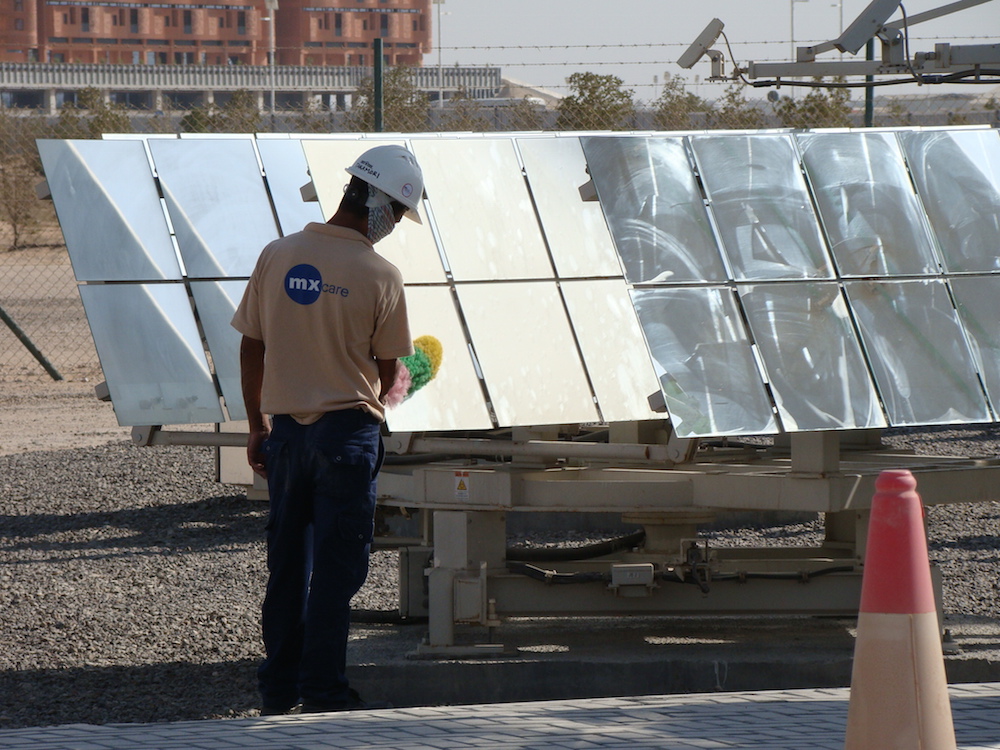
While there was extensive research toward a solution for removing dust, humidity, and mud from solar panels in the UAE, during the time of our conversation, no technical solution had proved as effective as the use of labor. In Mahmood’s narrative, the “man with a brush,” a worker dedicated to gently wiping away dust and mud from the solar panels, became part of the picture mainly because he exposed the potential that is embedded in the solar panels. In some ways, “man with a brush” would allow for the proper functioning of not only the solar panels, but also the economic diversification project of Abu Dhabi. In this context, the “man with a brush,” who was essential to the construction and maintenance of the spaceship, was framed as a disposable tool and abandoned outside the technologically complex vessel.
Connected Isolation
Released in 2014, the science fiction film Interstellar portrays a nearly uninhabitable world consumed by dust storms. Life becomes increasingly difficult for the film’s protagonists as they lack breathable air and nutritious crops. Fast-forward to the final scenes of the movie, however, and the protagonists have arrived in a peaceful spaceship floating far away from earth, one that contains the same house, town, and lifestyle they occupied on earth. In preserving the status quo the residents of the spaceship have left the rest of the earth to its collapse, celebrating the fact that they can inhabit technological dreams without attending to problems on earth in a collective manner.
In Interstellar, the American house, the baseball fields, and the beer bottles stand in as manifestations of what Sloterdijk calls “connected isolation.”21 To construct an artificial lifeworld inside the spaceship, materials, designs, and building techniques have been imported, allowing the frontierspeople to fall back on their prior social lives and political conceptions. In a context of complete isolation, the absence of these attachments could perhaps facilitate the production of more radical transformations. But as Sloterdijk argues, “All current and future space-insulators will remain imitators, like their distant forefather Robinson Crusoe… [and] create things exclusively out of what they brought with them, just as he did. It goes without saying that conventional astronauts are far removed from being the pure consciousness of their island.”22 The inhabitants of the spaceship are bound by imported ideas that preclude the necessary shifts in perspective.
Despite the numerous technical adjustments they offer, contemporary forms of urban development, such as Masdar City, produce future scenarios that are akin to Interstellar, inviting future residents to both preserve existing social relations and survive ecological disasters inside serene and optimistic spaceships—so caringly cultivated, and as the Richard Brautigan poem goes, “all watched over by machines of loving grace.”23
-
Laura Stupin, “I Live in a Spaceship in the Middle of the Desert,” September 25, 2010, link. ↩
-
John Vidal, “Masdar City: A Glimpse of the Future in the Desert,” the Guardian, April 26, 2011, link. ↩
-
Peder Anker, From Bauhaus to Eco-house: A History of Ecological Design (Baton Rouge: Louisiana State University Press, 2010). Also see Sabine Höhler, Spaceship Earth in the Environmental Age, 1960–1990 (London: Pickering and Chatto, 2015). ↩
-
Hans Blumenthal, Shipwreck with Spectator: Paradigm of a Metaphor for Existence (Cambridge, MA: MIT Press, 1996), 8. ↩
-
Peter Sloterdijk, Globes: Spheres 2 (South Pasadena: Semiotext(e), 2014). ↩
-
Buckminster Fuller, Operating Manual for Spaceship Earth (1969; Rotterdam: Lars Müller, 2008). See also Peder Anker, From Bauhaus to Eco-house: A History of Ecological Design (Baton Rouge: Louisiana State University Press, 2010). ↩
-
Fuller, Operating Manual for Spaceship Earth, 52–54. ↩
-
Ernst von Meijenfeldt and Marit Geluk, Below Ground Level: Creating New Spaces for Contemporary Architecture (Basel: Birkhäuser-Publishers for Architecture, 2003), 130. ↩
-
Thomas Tse Kwai Zung, Buckminster Fuller: Anthology for a new Millennium (New York: St. Martin’s Press, 2002), 2. ↩
-
Jonathan Glancey, “Man on the moon: Norman Foster prepares for architecture’s lift-off,” Guardian, September 9, 2009, link. ↩
-
Norman Foster takes on Mars: Rachel Reilly, “Architect’s Firm Reveals their Award-Winning Vision for an Astronaut’s Life on the Red Planet,” Daily Mail, September 29, 2015, link. Also see: Amy Frearson, “Foster + Partners Reveals Concept for 3-D-Printed Mars Habitat Built by Robots,” Dezeen, September 25, 2015, link. ↩
-
Timur Moon, “Norman Foster: Building an Oasis,” the National, November 28, 2010, link. ↩
-
Tom Heap, “Masdar: Abu Dhabi’s Carbon Neutral City,” BBC News, March 28, 2010, link. ↩
-
Al-Gurg, Easa Saleh, The Wells of Memory: An Autobiography (London: J. Murray, 1998). Easa Al-Gurg started one of the UAE’s most prominent family businesses in 1960, after gaining considerable experience in the fields of banking and finance. He was an adviser to Sheikh Rashid, the late ruler of Dubai, and was also one of the people who attended the meetings in which the UAE was formed on December 2, 1971. Easa Al-Gurg also served as UAE ambassador to the UK and the Republic of Ireland for almost two decades, starting in 1991. ↩
-
Richard Quest, “World’s Most Futuristic City” CNN, December 6, 2010, link. Fred Moavenzadeh repeated this claim in an interview with Wired magazine in 2013, suggesting: “When you look at the whole concept of Masdar in the 21st century, it’s the same as NASA in the 20th century… It has the same rationale, the same philosophy. NASA put a man on the Moon to show the strengths of the United States in that area of technology. And Masdar is being developed to show Abu Dhabi’s commitment to clean air and technology.” See Patrick Kingsley, “Masdar: the Shifting Goalposts of Abu Dhabi’s Ambitious Eco-city,” Wired, December 17, 2013, link. Interestingly, in 2015 the Dubai government set up the Mohammed bin Rashid Space Centre in an attempt to prompt economic diversification, scientific research, and technological complexity in Dubai and the wider UAE. So far the center has conducted projects in collaboration with the South Korean space program and aims to send a probe to Mars. For more information, see their website. Also see the Guardian article about the space center: Kareem Shaheen, “Emirates Space Mission Hopes to Launch New Era in Middle East,” the Guardian, July 19, 2015, link. ↩
-
Looking back at the Apollo space program (which the president of Masdar Institute touched upon in Richard Quest’s CNN documentary), David Mindell explains how President Kennedy had seized and mobilized the powerful mythology of the frontier in aiming for the moon. The term frontier, originally meaning “border” or “borderline,” obtained new meaning during the settlement of the American West in the eighteenth and nineteenth centuries. In this narrative, the heroic pioneers were headed to an unknown geography full of unpredictable dangers as well as antagonistic competitors, yet they would make use of self-control, self-reliance, and humility to open up this new frontier. David Mindell, Digital Apollo: Human and Machine in the First Six Lunar Landings(Cambridge: MIT Press, 2008). ↩
-
Timothy Mitchell, Carbon Democracy, (New York: Verso, 2012). ↩
-
For a longer exploration of this theme, see Rosalind Williams, Notes on the Underground: An Essay on Technology, Society, and the Imagination (1990; Cambridge MA: MIT Press, 2008), 7. ↩
-
As Sabine Höhler reminds her readers, “Appropriating space by compiling, registering, and neatly arranging the elements within it is a strategy not limited to the modern era of scientific collecting, archiving, and interpreting of the world. The procedure recalls the primal ship representing the inventory of the world, the biblical ark.” Sabine Höhler, “The Environment as a Life Support System: the Case of Biosphere 2,” History and Technology vol. 26, no. 1: 39–58. Also see Sabine Höhler, Spaceship Earth in the Environmental Age, 1960–1990 (London: Pickering and Chatto, 2015). ↩
-
For a review of these figures, please see “Work starts on Gulf ‘green city,’” BBC News , February 10, 2008, link. ↩
-
Peter Sloterdijk, “The Absolute Island,” in Olafur Eliasson: Minding the World, ed. Olafur Eliasson and Gitte Orskou (Denmark: ARoS Aarhus Kunstmuseum, 2004), 161. ↩
-
Sloterdijk, “Absolute Island,” 162. ↩
-
Richard Brautigan, All Watched Over by Machines of Loving Grace , (San Francisco: Communication Company, 1967). Available here. ↩
Gökçe Günel is a lecturer in anthropology at Columbia University. She finished her Ph.D. in anthropology at Cornell University in 2012. Her forthcoming book, titled Spaceship in the Desert: Energy, Climate Change, and Green Business in Abu Dhabi, focuses on the construction of renewable energy and clean technology infrastructures in the United Arab Emirates, more specifically concentrating on the Masdar City project.

